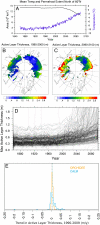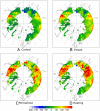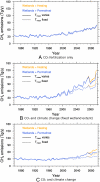Permafrost carbon-climate feedbacks accelerate global warming - PubMed (original) (raw)
Permafrost carbon-climate feedbacks accelerate global warming
Charles D Koven et al. Proc Natl Acad Sci U S A. 2011.
Abstract
Permafrost soils contain enormous amounts of organic carbon, which could act as a positive feedback to global climate change due to enhanced respiration rates with warming. We have used a terrestrial ecosystem model that includes permafrost carbon dynamics, inhibition of respiration in frozen soil layers, vertical mixing of soil carbon from surface to permafrost layers, and CH(4) emissions from flooded areas, and which better matches new circumpolar inventories of soil carbon stocks, to explore the potential for carbon-climate feedbacks at high latitudes. Contrary to model results for the Intergovernmental Panel on Climate Change Fourth Assessment Report (IPCC AR4), when permafrost processes are included, terrestrial ecosystems north of 60°N could shift from being a sink to a source of CO(2) by the end of the 21st century when forced by a Special Report on Emissions Scenarios (SRES) A2 climate change scenario. Between 1860 and 2100, the model response to combined CO(2) fertilization and climate change changes from a sink of 68 Pg to a 27 + -7 Pg sink to 4 + -18 Pg source, depending on the processes and parameter values used. The integrated change in carbon due to climate change shifts from near zero, which is within the range of previous model estimates, to a climate-induced loss of carbon by ecosystems in the range of 25 + -3 to 85 + -16 Pg C, depending on processes included in the model, with a best estimate of a 62 + -7 Pg C loss. Methane emissions from high-latitude regions are calculated to increase from 34 Tg CH(4)/y to 41-70 Tg CH(4)/y, with increases due to CO(2) fertilization, permafrost thaw, and warming-induced increased CH(4) flux densities partially offset by a reduction in wetland extent.
Conflict of interest statement
The authors declare no conflict of interest.
Figures
Fig. 1.
Change in permafrost extent and properties over the model simulation period, for the region 60°N–90°N. (A) Black line, permafrost extent (to 50 m); blue line, mean annual temperature for the high-latitude terrestrial region. (B) Active layer thickness (maximum depth of seasonally thawed soils), 1990–2000. (C) Active layer thickness, 2090–2100. Blank grid cells in (B_–_C) are those where we do not calculate permafrost within the top 50 m. (D) Trends in active layer thickness for all permafrost grid cells in the model. (E) A histogram of modeled and observed [CALM, (25)] active layer thickness trends (m/y) based on regression over the period 1990–2009.
Fig. 2.
Change in carbon fluxes over the model run. (A) Mean fluxes over modeled period. Contemporary budget estimate from McGuire et al. (1) (B) integrated changes. (C) Integrated changes in carbon balance due to rising CO2 concentration alone. (D) Integrated change in carbon balance due to climate change alone (difference between CO2-only and CO2+climate change).
Fig. 3.
Spatial patterns of net CO2 fluxes due to climate change at end of 21st century, for (A) control, (B) freeze, (C) permafrost, and (D) heating experiments. Units are in gC/m2/y. Outlined cells are initialized as containing deep yedoma carbon.
Fig. 4.
CH4 fluxes from high-latitude region over model runs (Tg CH4). (A) CH4 emissions under CO2 fertilization alone; (B) CH4 emissions under combined CO2 increase and climate change, but holding wetland extent fixed; (C) CH4 emissions under full climate change experiment with CO2, climate, and its effect on wetland extent all varying. For each case, two separate wetland CH4 experiments were carried out, with the reference temperature for methanogenesis, _T_mean, remaining fixed or changing with climate. In addition, two separate permafrost CH4 experiments were carried out, corresponding to the permafrost and heating experiments for the carbon balance.
Similar articles
- Permafrost carbon cycle and its dynamics on the Tibetan Plateau.
Chen L, Yang G, Bai Y, Chang J, Qin S, Liu F, He M, Song Y, Zhang F, Peñuelas J, Zhu B, Zhou G, Yang Y. Chen L, et al. Sci China Life Sci. 2024 Sep;67(9):1833-1848. doi: 10.1007/s11427-023-2601-1. Epub 2024 Jun 26. Sci China Life Sci. 2024. PMID: 38951429 Review. - A simplified, data-constrained approach to estimate the permafrost carbon-climate feedback.
Koven CD, Schuur EA, Schädel C, Bohn TJ, Burke EJ, Chen G, Chen X, Ciais P, Grosse G, Harden JW, Hayes DJ, Hugelius G, Jafarov EE, Krinner G, Kuhry P, Lawrence DM, MacDougall AH, Marchenko SS, McGuire AD, Natali SM, Nicolsky DJ, Olefeldt D, Peng S, Romanovsky VE, Schaefer KM, Strauss J, Treat CC, Turetsky M. Koven CD, et al. Philos Trans A Math Phys Eng Sci. 2015 Nov 13;373(2054):20140423. doi: 10.1098/rsta.2014.0423. Philos Trans A Math Phys Eng Sci. 2015. PMID: 26438276 Free PMC article. - The role of environmental driving factors in historical and projected carbon dynamics of wetland ecosystems in Alaska.
Lyu Z, Genet H, He Y, Zhuang Q, McGuire AD, Bennett A, Breen A, Clein J, Euskirchen ES, Johnson K, Kurkowski T, Pastick NJ, Rupp TS, Wylie BK, Zhu Z. Lyu Z, et al. Ecol Appl. 2018 Sep;28(6):1377-1395. doi: 10.1002/eap.1755. Epub 2018 Jun 25. Ecol Appl. 2018. PMID: 29808543 - When could global warming reach 4°C?
Betts RA, Collins M, Hemming DL, Jones CD, Lowe JA, Sanderson MG. Betts RA, et al. Philos Trans A Math Phys Eng Sci. 2011 Jan 13;369(1934):67-84. doi: 10.1098/rsta.2010.0292. Philos Trans A Math Phys Eng Sci. 2011. PMID: 21115513 - Effects of changes in climate on landscape and regional processes, and feedbacks to the climate system.
Callaghan TV, Björn LO, Chernov Y, Chapin T, Christensen TR, Huntley B, Ims RA, Johansson M, Jolly D, Jonasson S, Matveyeva N, Panikov N, Oechel W, Shaver G, Schaphoff S, Sitch S. Callaghan TV, et al. Ambio. 2004 Nov;33(7):459-68. doi: 10.1579/0044-7447-33.7.459. Ambio. 2004. PMID: 15573573 Review.
Cited by
- Effects of winter soil warming on crop biomass carbon loss from organic matter degradation.
Ni H, Hu H, Zohner CM, Huang W, Chen J, Sun Y, Ding J, Zhou J, Yan X, Zhang J, Liang Y, Crowther TW. Ni H, et al. Nat Commun. 2024 Oct 14;15(1):8847. doi: 10.1038/s41467-024-53216-2. Nat Commun. 2024. PMID: 39397050 Free PMC article. - Permafrost carbon cycle and its dynamics on the Tibetan Plateau.
Chen L, Yang G, Bai Y, Chang J, Qin S, Liu F, He M, Song Y, Zhang F, Peñuelas J, Zhu B, Zhou G, Yang Y. Chen L, et al. Sci China Life Sci. 2024 Sep;67(9):1833-1848. doi: 10.1007/s11427-023-2601-1. Epub 2024 Jun 26. Sci China Life Sci. 2024. PMID: 38951429 Review. - Phosphorus Interactions with Iron in Undisturbed and Disturbed Arctic Tundra Ecosystems.
Berens MJ, Michaud AB, VanderJeugdt E, Miah I, Sutor FW, Emerson D, Bowden WB, Kinsman-Costello L, Weintraub MN, Herndon EM. Berens MJ, et al. Environ Sci Technol. 2024 Jul 2;58(26):11400-11410. doi: 10.1021/acs.est.3c09072. Epub 2024 Jun 18. Environ Sci Technol. 2024. PMID: 38889135 Free PMC article. - Microbial polyphenol metabolism is part of the thawing permafrost carbon cycle.
McGivern BB, Cronin DR, Ellenbogen JB, Borton MA, Knutson EL, Freire-Zapata V, Bouranis JA, Bernhardt L, Hernandez AI, Flynn RM, Woyda R, Cory AB, Wilson RM, Chanton JP, Woodcroft BJ, Ernakovich JG, Tfaily MM, Sullivan MB, Tyson GW, Rich VI, Hagerman AE, Wrighton KC. McGivern BB, et al. Nat Microbiol. 2024 Jun;9(6):1454-1466. doi: 10.1038/s41564-024-01691-0. Epub 2024 May 28. Nat Microbiol. 2024. PMID: 38806673 Free PMC article. - The fusion of multiple scale data indicates that the carbon sink function of the Qinghai-Tibet Plateau is substantial.
Zeng J, Zhou T, Xu Y, Lin Q, Tan E, Zhang Y, Wu X, Zhang J, Liu X. Zeng J, et al. Carbon Balance Manag. 2023 Sep 11;18(1):19. doi: 10.1186/s13021-023-00239-9. Carbon Balance Manag. 2023. PMID: 37695559 Free PMC article.
References
- McGuire AD, et al. Sensitivity of the carbon cycle in the Arctic to climate change. Ecol Monogr. 2009;79:523–555.
- Knorr W, Prentice I, House J, Holland E. Long-term sensitivity of soil carbon turnover to warming. Nature. 2005;433:298–301. - PubMed
- Schuur EAG, et al. The effect of permafrost thaw on old carbon release and net carbon exchange from tundra. Nature. 2009;459:556–559. - PubMed
- Tarnocai C, et al. Soil organic carbon pools in the northern circumpolar permafrost region. Global Biogeochem Cycles. 2009;23:GB2023.
- Friedlingstein P, et al. Climate-carbon cycle feedback analysis: Results from the C4MIP model intercomparison. J Clim. 2006;19:3337–3353.
Publication types
MeSH terms
Substances
LinkOut - more resources
Full Text Sources
Miscellaneous



